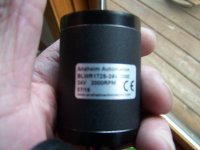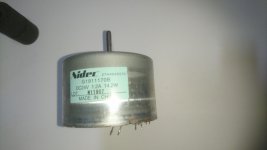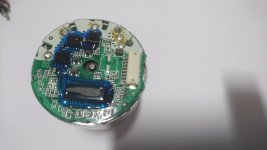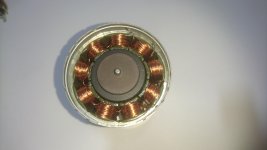It is acrylic, 3 3/8 thick it weighs 17 lbs..
Will be interesting, I have run acrylic platters on other decks and liked the sound.
Will be interesting, I have run acrylic platters on other decks and liked the sound.
I'm curious as to how to determine what is an adequate power supply to drive the 25W SE 3123 based amps to an appropriate output for the BLDC motor you are using. The eBay units appear to have a pot integrated to regulate output and state they can utilize a power supply anywhere from 10-25V DC.
My local Radio Shack recently liquidated, and I went kind of nuts. I got 6 laptop Enercell power supplies for $10 each. Their stated output is 19V DC at 90W/4.7Amps and supposedly are regulated/filtered output. It would be nice if I could use one of these to power the amps at least. I have measured and confirmed the output at 19V DC.
Since I already purchased extra boards, I am interested in trying to use the SG4 with these 3123 eBay amps to drive the same BLDC motor you are using directly if possible. I am able to make any size pulley I need with my lathe, and since I only need 33 and 45 RPM on the table I was just going to turn a two tiered pulley and set one frequency to drive the system.
I realize the SG4 has frequency adjustment limitations, perhaps using the same motor requires a different size pulley to get the RPM/frequency relationship correct on my table?
There are other BLDC motors of course...I think you suggested a different Anaheim model might work better for a TD124. I'm not sure if I am in the same boat with my HW19. I have a 12" platter I could run on it...and actually would like to.
My local Radio Shack recently liquidated, and I went kind of nuts. I got 6 laptop Enercell power supplies for $10 each. Their stated output is 19V DC at 90W/4.7Amps and supposedly are regulated/filtered output. It would be nice if I could use one of these to power the amps at least. I have measured and confirmed the output at 19V DC.
Since I already purchased extra boards, I am interested in trying to use the SG4 with these 3123 eBay amps to drive the same BLDC motor you are using directly if possible. I am able to make any size pulley I need with my lathe, and since I only need 33 and 45 RPM on the table I was just going to turn a two tiered pulley and set one frequency to drive the system.
I realize the SG4 has frequency adjustment limitations, perhaps using the same motor requires a different size pulley to get the RPM/frequency relationship correct on my table?
There are other BLDC motors of course...I think you suggested a different Anaheim model might work better for a TD124. I'm not sure if I am in the same boat with my HW19. I have a 12" platter I could run on it...and actually would like to.
Last edited:
If you use the BLWS231S-24V-2000 motor, you will need ~12VPP at 600 RPM for 12W. The 19VDC supplies should be adequate for this. The motor has a ¼" shaft.
The SG4 will need v1.03 firmware which reduces the lower frequency limit to 1Hz. With the above motor, 20Hz will produce 600 RPM.
The SG4 will need v1.03 firmware which reduces the lower frequency limit to 1Hz. With the above motor, 20Hz will produce 600 RPM.
3. The voltage has to be adjusted to match the speed. The easiest way to do this is to monitor the DC power going into the amps and adjust the voltage so the amp/motor combo is drawing rated power at the current speed. If the motor is 12W and you are using a 24VDC supply with class AB amps, then the DC current draw should be ~1A (24 x 1 x 50% eff=12W to the motor). This makes changing speeds more difficult as the motor will require more voltage the faster it spins to maintain rated power.
4. Reduce the voltage after the platter is up to speed. BLDC motors are much more efficient than AC synch and produce 2-3x the torque for the same power rating. The platter does not need that much torque once it is moving. If you don't reduce the power from the rated max, the motor will get very hot (140-150°F on a 12W motor) after 1 hour continuous use.
Hi Bill
Thanks for your response. It left me wondering about your statement above and a few other things. Is all needed voltage regulation accomplished through programming of the IC?...or would I have to address the fact that I was considering the use of these 19VDC laptop supplies and that I may be over driving the amps, not optimizing the current delivered to the motor and risking over heating it?
You stated I would need 12VPP (about 4.25Vrms?)...I'm not clear if that is at the input of the amp or motor. Would I still be using a pot to regulate the input voltage delivered to the amps to control things for the motor and not overheat it?
I thought there was programming already in place in the SG4 to ramp up speed with the torque needed to get the platter going without burning out and then reducing and stabilizing it once up to speed?
I was thinking about your suggestion to InSides that using the BLWR series motor might work out better for his situation. You stated they are 8 pole motors and for 600 RPM would require 40Hz to drive them. However, I'm wondering if you consider the BLWS series superior.
I'm shooting for 600 RPM and could be content using the BLWR series motor with a two tiered pulley to get 33 and 45 RPM (actually one of my VPI pulleys adapted to the 4mm shaft).
I don't remember if you said the current programming on the SG4 IC allows for the 40Hz needed or if it would give proper voltage regulation for start up and cruising speed in this application.
Sorry if I'm being a bore...perhaps the easiest solution is to just wait for a firmware update and follow whatever model hopefully develops.
One of the challenges of doing a 3 phase BLDC design, is the controller needs to be closely matched to the motor. This will not be a universal BLDC motor supply; it will be optimized for a select few motors. If you use it for driving something else, you're on your own and you will need to adjust the parameters accordingly.
12VPP would be at the input to the motor (all 3 phases). The 3 channel amp I'm working on has a summing test point that will easily allow you to balance the 3 signals.
The SG4 does not ramp the frequency, it ramps the voltage at start up to prevent the amps from going into overload and shutting down. The Condor controller does ramp freq and voltage.
The BLWR and BLWS motors are similar characteristics, but slightly different in execution. Not only is the frequency different, but the drive level is also somewhat different, but similar.
V1.02 of the SG4 will go down to 40.00 Hz. This will produce 600 RPM on the BLWR motor, but not much adjustment range to the low side. V1.03 will go down to 1.00 Hz.
That was the general idea. The SG4 ramps up to maximum voltage at start up, then drops to a user programmed level after 5 secs. You will need to set the attenuation into the amps to produce 12VPP output at start up. The SG4 reduced voltage should then be adjusted to ensure the motor does not overheat if running continuously for several hours.
12VPP would be at the input to the motor (all 3 phases). The 3 channel amp I'm working on has a summing test point that will easily allow you to balance the 3 signals.
The SG4 does not ramp the frequency, it ramps the voltage at start up to prevent the amps from going into overload and shutting down. The Condor controller does ramp freq and voltage.
The BLWR and BLWS motors are similar characteristics, but slightly different in execution. Not only is the frequency different, but the drive level is also somewhat different, but similar.
V1.02 of the SG4 will go down to 40.00 Hz. This will produce 600 RPM on the BLWR motor, but not much adjustment range to the low side. V1.03 will go down to 1.00 Hz.
Sorry if I'm being a bore...perhaps the easiest solution is to just wait for a firmware update and follow whatever model hopefully develops.
That was the general idea. The SG4 ramps up to maximum voltage at start up, then drops to a user programmed level after 5 secs. You will need to set the attenuation into the amps to produce 12VPP output at start up. The SG4 reduced voltage should then be adjusted to ensure the motor does not overheat if running continuously for several hours.
I think both series motors will work, but they will have different set up and adjustment levels.
The BLWR motor has a 4mm shaft but there are sleeves available to convert it to 3/16" so it will work with some existing VPI pulleys. The motor is taller than the Hursts and does not have a mounting flange.
The BLWS motor has a ¼" shaft so it needs a custom pulley, but it is the same form factor as the Hurst motors and nearly identical mounting flange.
The BLWR motor has a 4mm shaft but there are sleeves available to convert it to 3/16" so it will work with some existing VPI pulleys. The motor is taller than the Hursts and does not have a mounting flange.
The BLWS motor has a ¼" shaft so it needs a custom pulley, but it is the same form factor as the Hurst motors and nearly identical mounting flange.
I plan on having a pulley machined.
From what I have seen on pulleys available from VPI and the asking prices, it will be a wash anyway.
I have to build a motor housing, so I can work with what ever mounts they have
Glad to hear I didnt totally ball this up.
Sweet
Thank YOU
From what I have seen on pulleys available from VPI and the asking prices, it will be a wash anyway.
I have to build a motor housing, so I can work with what ever mounts they have
Glad to hear I didnt totally ball this up.
Sweet
Thank YOU
maybe a bit off the topic.. but i would suppose for a turntable it would be verry desirable to have the most constant speed possible. so when motors run stuff they don't give a constant tourqe, there is a ripple.
how about using a high speed motor, and gearing it down. if the controll circuitry can maintain a set speed of ... say just throwing random numbers , 4000 rpm with a ripple of no more than 10 rpm, and you would gear that down to 45 rpm, then would the ripple allso be less in rpm. and you would have a really high tourqe available to keep the recrod spinning.
maybe a nother interesting thing would be suspending a weight on a wire, the other end of the wire would be on a drumm. most probably matching speed could be done if the weight would be a magnet, and you could use an electromagnet to controll the constant tourqe. not sure how mutch power it takes to play a record tho.. but the pulseless constant tourqe might be achieveable and benefit.
//just some random stuff. sry for the off topic//
how about using a high speed motor, and gearing it down. if the controll circuitry can maintain a set speed of ... say just throwing random numbers , 4000 rpm with a ripple of no more than 10 rpm, and you would gear that down to 45 rpm, then would the ripple allso be less in rpm. and you would have a really high tourqe available to keep the recrod spinning.
maybe a nother interesting thing would be suspending a weight on a wire, the other end of the wire would be on a drumm. most probably matching speed could be done if the weight would be a magnet, and you could use an electromagnet to controll the constant tourqe. not sure how mutch power it takes to play a record tho.. but the pulseless constant tourqe might be achieveable and benefit.
//just some random stuff. sry for the off topic//
Received my Anaheim motor today, quite a substantial difference from the other motors I have worked with as far as build quality.
Would not want to drop it on my toe.
I would agree. They are really nice motors. I am shocked at the crappie motors (hurst) that VPI charges a premium for.
I think they are on par with $300 Bosch or Maxon motors; they certainly make the Hurst motors look like toys.
On the BLWR series, the sensor assembly cannot be easily removed from the motor. I ended up just cutting the leads off inside. On the BLWS series, the whole sensor assembly can be removed with 2 screws. You can also just leave the wires hanging.
On the BLWR series, the sensor assembly cannot be easily removed from the motor. I ended up just cutting the leads off inside. On the BLWS series, the whole sensor assembly can be removed with 2 screws. You can also just leave the wires hanging.
I think they are on par with $300 Bosch or Maxon motors; they certainly make the Hurst motors look like toys.
On the BLWR series, the sensor assembly cannot be easily removed from the motor. I ended up just cutting the leads off inside. On the BLWS series, the whole sensor assembly can be removed with 2 screws. You can also just leave the wires hanging.
I think I will just leave them, dont want to take a chance on messing something up.
My cheap Nidec motors have arrived, after removing the control board it was quite easy to undo the wiring ro create three separate windings. This allowed me to connect the windings directly to the outputs of my little class D BTL amps, but as the DC resistance is so low (about 1 Ohm) I need to add an extra 1 Ohm resistor to each output.
It's interesting that the speed is, as expected, directly related to the frequency, but oddly 600 rpm is achieved with 60hz. The torque is more than adequate, but even with careful adjustment to the phase settings it is not possible to reduce the vibration to zero as it is with a Papst delta wound synchronous AC motor., but running at a much lower speed with a much smaller mass makes the small amount of residual vibration easy to deal with.
It's interesting that the speed is, as expected, directly related to the frequency, but oddly 600 rpm is achieved with 60hz. The torque is more than adequate, but even with careful adjustment to the phase settings it is not possible to reduce the vibration to zero as it is with a Papst delta wound synchronous AC motor., but running at a much lower speed with a much smaller mass makes the small amount of residual vibration easy to deal with.
Attachments
Nidec make some of the Hurst motors and they appear to be constructed the same way, with only one bearing at the top. If the rotor is not supported on the bottom and is not perfectly balanced, it will vibrate when spinning.
Stripped the Nidec motor down, the phosphor bronze bearing is in two sections, one at the top, the other at the base. The rotor is held in place by the magnetic field, along with two nylon washers, one each side of the top plate. I've removed the washers, and will use a plate to provide support. The motors are not completely silent, but I can't hear them from as little as a foot away
Unfortunately the motors available in the US are not so easy to obtain in Europe, so I'm currently looking at alternatives.
Unfortunately the motors available in the US are not so easy to obtain in Europe, so I'm currently looking at alternatives.
Hi Ralph
Where you able to use the btl amps without transformers? It was my understanding that you need single ended amps to go directly to bldc motors. It is interesting that you are getting 600 rpm with 60 hz. The anahiem site has all kinds of rpms on 4 pole and 8 pole motors.
Tom
Where you able to use the btl amps without transformers? It was my understanding that you need single ended amps to go directly to bldc motors. It is interesting that you are getting 600 rpm with 60 hz. The anahiem site has all kinds of rpms on 4 pole and 8 pole motors.
Tom
How is the motor for cogging?
If I feed it with a 1Hz signal the rotor takes 6 seconds to rotate 1 turn, with no visible, or tactile impression of cogging. I'm actually very impressed with this little motor, it needs little drive voltage, not surprising with the very low winding resistance, in fact the voltage across the motor winding is only a little over 2V.
I might even try using transformers, but in step-down mode. This would allow me to drive the motor more efficiently by getting rid of the 1.0 ohm resistors.
I'm thinking about using 120:24, or about 5:1 should do the trick
I'll try this out tomorrow and report back.
I can get away with the BTL amplifiers because I'm unwinding the common star point and creating 3 separate windings in the motor.Hi Ralph
Where you able to use the btl amps without transformers? It was my understanding that you need single ended amps to go directly to bldc motors. It is interesting that you are getting 600 rpm with 60 hz. The anahiem site has all kinds of rpms on 4 pole and 8 pole motors.
Tom
- Home
- Source & Line
- Analogue Source
- 3 Phase BLDC motor for turntable use?



